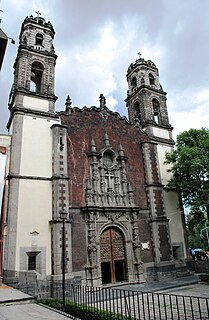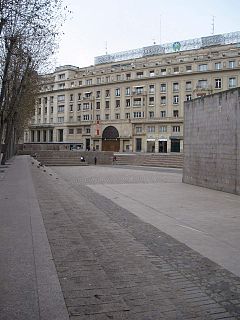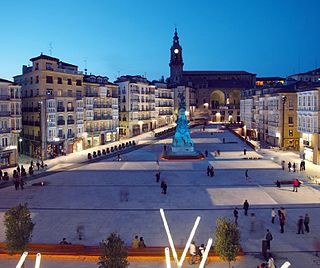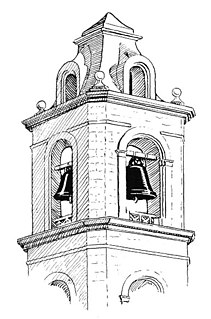
The Cathedral of Saint Mary of Burgos is a Catholic church dedicated to the Virgin Mary located in the Spanish city of Burgos. Its official name is Santa Iglesia Catedral Basílica Metropolitana de Santa María de Burgos. Its construction began in 1221, following French Gothic patterns. It went through major changes in the 15th and 16th centuries: the spires of the main facade, the Chapel of the Constable and dome of the transept, elements of the advanced Gothic which give the temple its unmistakable profile. The last works of importance were constructed in the 18th century, in which the Gothic portals of the main facade were also modified. The style of the cathedral is the Gothic, although it has several decorative Renaissance and Baroque elements as well. The construction and renovations were made with limestone extracted from the quarrys of the nearby town of Hontoria de la Cantera.

Santa María de León Cathedral, also called The House of Light or the Pulchra Leonina is situated in the city of León in north-western Spain. It was built on the site of previous Roman baths of the 2nd century which, 800 years later, king Ordoño II converted into a palace.

The Metropolitan Cathedral of the Assumption of the Most Blessed Virgin Mary into Heavens is the seat of the Roman Catholic Archdiocese of Mexico. It is situated atop the former Aztec sacred precinct near the Templo Mayor on the northern side of the Plaza de la Constitución in Downtown Mexico City. The cathedral was built in sections from 1573 to 1813 around the original church that was constructed soon after the Spanish conquest of Tenochtitlan, eventually replacing it entirely. Spanish architect Claudio de Arciniega planned the construction, drawing inspiration from Gothic cathedrals in Spain.
Villanueva de la Jara, popularly called La Jara, is a town and municipality in the Manchuela Conquense cormarca, this in turn is part of the La Manchuela comarca, province of Cuenca, in Castile-La Mancha, Spain. It is known for the cultivation of portobellos which is the main economic activity of the locality and other edible fungis.

San Pedro Cholula is a municipality in the Mexican state of Puebla and one of two municipalities which made up the city of Cholula. The city has been divided into two sections since the pre Hispanic era, when revolting Toltec-Chichimecas pushed the formerly dominant Olmec-Xicallanca to the eastern side of the city in the 13th century. The new lords called themselves Cholutecas and built a new temple to Quetzalcoatl on the San Pedro side, which eventually eclipsed the formerly prominent Great Pyramid of Cholula, now on the San Andrés side. When the Spanish arrived in the 16th century, the city of Cholula was an important religious and economic center, but the center of power was on the San Pedro side, centered on what is now the main city plaza and the San Gabriel monastery. The division of the city persisted and San Pedro remained the more dominant, with Spanish families moving onto that side and the rest of the population quickly becoming mestizo. Today, San Pedro is still more commercial and less residential than neighboring San Andrés with most of its population employed in industry, commerce and services rather than agriculture. Although Cholula's main tourist attraction, the Pyramid, is in San Andrés, San Pedro has more tourism infrastructure such as hotels, restaurants and bars.

The Santa Veracruz Church in the historic center of Mexico City is one of the oldest religious establishments in Mexico City and was the third most important church in the area in the 16th century. It was established by a religious brotherhood founded by Hernán Cortés.

The Botanical Garden of Santa Catalina or in Basque: “Santa Katalina Lorategi Botanikoa”, is a botanical garden about 32,500 meters square extension, in the municipality of Iruña de Oca, in the surroundings of Sierra de Badaya, province of Alava, autonomous community of the Basque Country, Spain. It’s a member of the Ibero Macaronesian association of Botanical Gardens.

Nanclares de la Oca in Spanish and Langraiz Oka in Basque, is a village located in the province of Álava,. It is also the capital village of the municipality of Iruña de Oca and the most populated village of the region named Cuadrilla de Añana.

The Fiestas de la Virgen Blanca have been celebrated every year, since 1884. It is held on 5 August, but the celebrations begin the day before, on the 4th, and end on 9 August it honours the patron saint of the city, and features a programme of special events, activities and free open-air concerts.

Celedón is a symbol of the villager native of Alava. Wearing a beret and dressed in a traditional blouse, always accompanied by an umbrella, the personage has been located by the historians in diverse environments. This man or personage opens the holidays of Vitoria-Gasteiz in the Basque province of Araba-Álava in Spain.
The Virgen Blanca is the patron saint of the Spanish city Vitoria-Gasteiz. Its festivity is celebrated on 5 August, commonly known as Andre Maria Zuriaren jaiak or las fiestas de la Blanca.

Blusas are Basque citizens who dress in the traditional clothes of the region and attend events in Vitoria-Gasteiz such as the Virgen Blanca Festivities. The blusas assemble in groups called cuadrillas and their main role is to provide entertainment at these events.
Anúcita/Anuntzeta is a village that belongs to the municipality of Ribera Alta and the Cuadrilla of Añana, in the judicial district of Vitoria-Gasteiz, Álava-Araba, in the Basque country of Spain. It lies at the foot of the mountain San Vitores and on the left bank of the Bayas River at an elevation of 580 m. The village is bordered to the north by Subijana and Morillas, to the east by Nubilla, to the south by Hereña, and to the west by Pobes.

The Plaza de los Fueros is a plaza or square located in the city centre of Vitoria-Gasteiz, which is the capital of the Basque Country, Spain. It was built in 1979 in memory of the county code of laws named fuero in Spanish.

The Iglesia de los Santos Justo y Pastor, popularly known as Iglesia de San Justo, is a church located in the city of Toledo. It was founded after the city was taken by King Alfonso VI of León and Castile in the 13th century. The city underwent transformations between the 14th and 18th centuries. This is a religious temple under the invocation of the holy children Justus and Pastor.





















